August 17, 2007
Air Date: August 17, 2007
FULL SHOW
SEGMENTS
National Parks and Climate Change
View the page for this story
Our national parks are beginning to feel the effects of global warming. Mark Wenzler from the National Parks Conservation Association tells host Steve Curwood about observed and projected changes from melting glaciers and extinction of trees, to rising sea levels. (07:15)
International Ship Pollution
/ Ingrid LobetView the page for this story
Politicians, health scientists and community members in California have been pushing to clean up emissions from international cargo ships. In Los Angeles, the ships emit half of all the region's sulfur oxide, a source of smog and dangerous particles. Now, thanks to growing research on health effects, there are signs that even the international shipping industry may be feeling the pressure to make changes. Ingrid Lobet reports. (04:30)
Libby, Montana
View the page for this story
In the small town of Libby, Montana, more than a thousand people have been diagnosed with lung disease and over 200 have died from exposure to vermiculite, a type of asbestos used for insulation in homes. The contaminated town became a Superfund site and executives from W.R. Grace, the company that owned the vermiculite mine, will soon go to trial on charges they covered up the extent of asbestos contamination in Libby and obstructed regulators from investigating. Host Steve Curwood talks with Drury Gunn Carr who co-directed a documentary on Libby, Montana, which will soon air on PBS’ POV series. (08:00)
Water Diaries
/ Jeff YoungView the page for this story
A billion people without safe water, twice that many with no sanitation. Figures on the global water crisis can be hard to absorb. So Living on Earth's Jeff Young recorded his daily water use, while a woman in rural India did the same. The result is a sobering glimpse into the global inequities of water and wealth. (09:00)
Cool Fix
/ Amy FishView the page for this story
Amy Fish reports on an Anglican bishop who’s preaching the green gospel, and practicing what he preaches to boot! (02:00)
Losing Linnaeus?
/ Ian GrayView the page for this story
The system we use to organize life is based on the work of the 18th century Swedish botanist Carl Linnaeus. But new tools, like DNA analysis, are giving modern taxonomists information about species that Linnaeus would never have dreamed of. Now, a group of scientists are suggesting that it's time to ditch the old organization of Kingdom, Phylum, Class, Order, Family, Genus, Species. Living on Earth's Ian Gray reports. (08:00)
Dog Days
View the page for this story
Writer Jon Katz moved from the suburbs to a rural farm, and has never looked back. Katz tells host Steve Curwood about his many four-legged friends and his latest book, “Dog Days: Dispatches from Bedlam Farm.” (06:45)
This week's EarthEar selection
listen /
download
Show Credits and Funders
Show Transcript
HOST: Steve Curwood,
GUEST: Mark Wenzler, Drury Gunn Carr, and Jon Katz
REPORTER: Ingrid Lobet, Jeff Young and Ian Gray
COOL FIX: Amy Fish
[THEME]
CURWOOD: From Public Radio International - this is Living on Earth.
[THEME]
CURWOOD: I’m Steve Curwood.
Imagine it took you much of the day just to get the water you need to drink and keep somewhat clean. A billion people don’t have to imagine—that’s the way they live now, and some say that gives the U.S. a great diplomatic opportunity.
WHITE: If the United States had a Marshall plan for water supply and said ‘we’re going to get water to a billion people around the world,’ you can imagine the goodwill that the United States would have.
CURWOOD: Also, a steer usually winds up as steak and hamburger. But not if he belongs to writer Jon Katz and his name is Elvis.
KATZ: He is sweet. How can I tell you? I never thought I would know a steer. I never thought I would love a steer. He comes up and puts his head on my shoulder. He likes to kiss me. He eats my hat. He can be a little drooly. You have not been kissed until you have been kissed by Elvis.
CURWOOD: Tales of Bedlam Farm and more this week on Living on Earth, stick around.
ANNOUNCER: Support for Living on Earth comes from the National Science Foundation and Stonyfield Farm.
[THEME]
National Parks and Climate Change
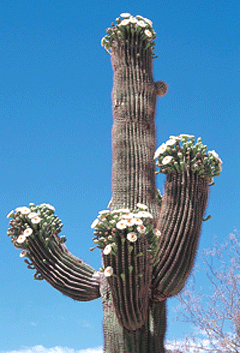
A saguaro cactus in bloom. (Courtesy of Arizona Game and Fish)
CURWOOD: From the Jennifer and Ted Stanley Studios in Somerville, Massachusetts - this is Living on Earth. I’m Steve Curwood. You probably have a favorite national park or two. Hopefully, you took some pictures the last time you were there to help you remember what you saw, because experts are now telling us that many of our national parks not only provide habitat for endangered species, but themselves are endangered by global warming. The latest report comes from the National Parks Conservation Association. Mark Wenzler is the director of Clean Air Programs for the Association. I spoke with him about a number of national parks starting with the Everglades in Florida. There, billions of dollars have been dedicated to restoration, so I asked if that money will be wasted with rising sea levels.
WENZLER: If you have to single out one park that’s most at risk it’s got to be the everglades because in fact, close to a third of southern Florida could be under water by the end of the century and that would completely obliterate that ecosystem. I would say that it’s not that the investments we’re making now aren’t worth it because they are shoring up the ecosystem and they’re going to help it withstand that sea level rise to a greater extent than it could have before. But certainly there’s a tremendous amount of investment that’s going to go to waste.
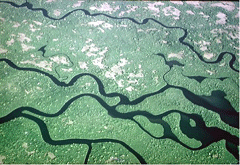
The Everglades in Florida may be underwater as sea level rises. (Courtesy of NASA)
WENZLER: It’s interesting to think that those parks, as hot as they are already, are going to suffer from additional heat but they will because the saguaro have adapted to live in a certain climate range and other species are kept out by that range. And as that range changes more species like invasive grasses will be able to move in. We see that happening now. And you really don’t have anything in those ecosystems right now that burns, in fact there have been very few fires in those ecosystems. But as these invasive grasses move in and dry out you’re going to see increasing amounts of wildfires that put the saguaro at risk.

A saguaro cactus in bloom.(Courtesy of Arizona Game and Fish)
WENZLER: Exactly. Anybody who watched Bugs Bunny in the 60’s or Road Runner has seen a lot of saguaro cactus.
CURWOOD: And what about Joshua Tree?
WENZLER: Joshua Tree is interesting. You know people often talk about ‘we’ll have to rename Glacier National Park because there won’t be any glaciers.’ But Joshua Tree we may have to rename as well because the trees are disappearing or are expected to disappear from the park by the end of the century. Those trees need a certain amount of cold weather to reproduce. I think it’s about one or two nights below freezing each year that help them release their seeds and reproduce. And that’s not going to be happening. They won’t be getting down to those temperatures. Those trees won’t be able to reproduce. Again you’ll have invasive grasses moving in to replace them. And certainly they’ll exist to a lesser extent outside the park but what’s predicted is within the boundaries of that Joshua Tree National Park we may not have any Joshua Trees.
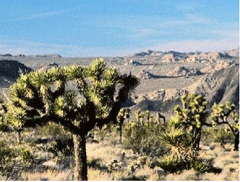
Joshua Tree national park may one day be without its namesake as the Joshua Trees migrate out of the park because of climate change. (Courtesy of USGS)
WENZLER: You know an interesting story is the grizzly bear at Yellowstone. People think of the grizzly bear and think what do they eat? Well they eat hikers, bear, moose, you know big things. But one of the most important food sources for grizzlies are pine nuts. And what’s happening is that the white bark pine beetle is becoming more prevalent as warmer temperatures take over the park. And they’re killing those trees. And there’s this unintended consequence where you know something happens and it changes something else and all of the sudden the grizzlies don’t have the food they need and they’ll have to move northward to find those trees that have those pine nuts.
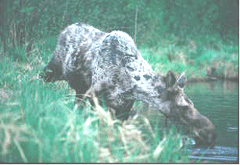
An increased number of ticks in Isle Royal National Park feed on moose such as this one. As a result the moose can develop anemia and alopecia. Those diseases kill the moose and negatively impacts wolf populations which feed on moose. (Courtesy of National Park Service)
CURWOOD: What are the other parks where you’re particularly concerned about invasive species and/or pests?
WENZLER: Well, you know you look at a park like Great Smokey Mountains National Park in Tennessee and North Carolina, and that park has already been very heavily impacted by invasive species like the adelgid, which have almost wiped out the hemlock trees. Climate change and warming temperatures are just going to make those kinds of pests thrive. And so it looks like we won’t be able to beat out the clock and save those trees. The adelgids are going to take off, they’re going to continue to decimate those forests.
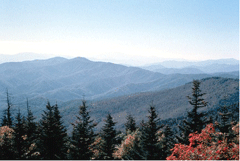
Great Smokey Mountains National Park is home to more tree species than in all of Europe. As the southern boundary for many of those trees some will leave the park as the climate warms. (Courtesy of National Park Service)
WENZLER: Well, that’s really bad. That’s probably some of the most dramatic changes that you can see today. You know people sometimes ask me “where can I go see climate change?” One place you definitely can see it is at Glacier National Park because you can go and see how extensive the glaciers were and how they’ve been reduced to almost nothing today. In fact I think we’ve only got a few more decades before they’re gone completely.
CURWOOD: Now Glacier of course is at risk. What are the other ones that come to mind?
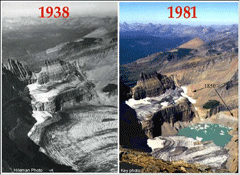
The extent of retreat of this glacier in Glacier National Park is documented by comparing photographs. Of the 150 glaciers observed in 1850 less than 30 remain today and those are expected to melt in the next 20 to 30 years. (Courtesy of National Park Service)
CURWOOD: This is all very gloomy here. What can we do specifically to help the parks?
WENZLER: Well, the parks are doing an interesting thing right now. The National Park Service just about a year or two ago began a program called Climate Friendly Parks. So, they’re doing things like investing in clean transportation systems, putting solar panels on visitor centers. They’re not just doing that for their own sake but also educating the public about what they can do at home.
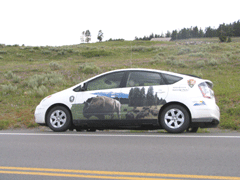
Some park rangers in Yellowstone National Park drive hybrid cars, like this Prius. Photo: Susan Trotz
And it’s a program that is growing. I think Glacier in Montana was one of the first, again given what’s at stake for that park. Zion down in Utah has some really innovative public transportation systems. Zion’s also got uh, being in the desert southwest, an extensive use of solar panels which is really interesting. Glacier Bay is also part of the Climate Friendly Parks program. And one of the big pollution sources up there are cruise ships. So Glacier Bay is working with the cruise industry to figure out how they can get them to reduce their emissions and protect the park. I guess if there’s any silver lining in this story it’s that it’s not too late to avoid some of the worst problems. And that’s why we’re trying to raise attention to this issue now. If we want to save these special places that tell the story of our nation and our shared natural history we’ve got to act now.
CURWOOD: Mark Wenzler is director of the clean air program for the National Parks Conservation Association and producer of their report Unnatural Disaster: Global Warming in our National Parks. Thanks so much Mark.
WENZLER: You’re welcome. Thank you.
[MUSIC: The Harvesters “This Land Is Your Land” from ‘Pastures of Plenty and Other Songs (Smithsonian Folkways Records - 1961)]
CURWOOD: To learn more about our national parks and climate change, go to our web site, loe.org. You can also get the inside scoop from Mark Wenzler about his favorite wild places, including some that most people don’t know about.
Related links:
- Click here to listen to Mark Wenzler talk about his favorite parks.
- Click here for a link to the National Park Service Podcast
- National Parks Conservation Association
- NPCA report on the effects of global warming in the national parks
- National Park Service
International Ship Pollution
CURWOOD: The Los Angeles Basin tends to trap air, and the California sun can turn exhaust and other emissions from the activities of 16 million people into choking clouds of smog. So air officials have cracked down on cars, trucks, tugboats, cranes and even trains. And now southern California clean air advocates are leading efforts to get national regulations to cap pollution from oceangoing freighters. They are demanding that the federal government take action now, rather than wait for international rules. Living on Earth’s Ingrid Lobet reports from Los Angeles.
LOBET: When both United States senators and two California congresswomen introduced legislation to clean up cargo ship engines recently, port neighborhoods in California cheered. The issue of trade-related pollution was finally being heard at the federal level. When several had the chance to speak to Senator Barbara Boxer at an August recess field hearing, the public packed the room. Roy Wilson, a county official in badly-polluted Riverside County made a point deeply felt here: That it’s unacceptable for a region that cracks down on drivers, on factories, on paints and dry cleaners to have a major polluter sitting untouched in its ports.
WILSON: It is shocking to consider that just upwind of our region, maritime vessels operate enormous engines, some of them three stories high, without any emission controls to speak of. These vessels also burn some of the dirtiest fuel in the world, literally the bottom of the barrel left after the refining process.
LOBET: This heavy ship fuel often contains hundreds of times more sulfur than what is now allowed in regular diesel fuel. California recently forced ships to switch to clean fuel as they enter port, and is being sued for it. The EPA says it’s working through proper international channels, specifically the International Maritime Organization towards the same end. Nearly everyone, including the shipping industry, says such international rules are the best way to address the issue. But people here say the international rules are taking too long and federal government needs to fill the gap. Ed Avol, an expert in air pollution health effects at the University of Southern California says lung damage is occurring now.
AVOL: Our studies have shown that children that grow up in more polluted areas have slower growing lungs. And that after years of losing a percent or two of lung growth, children in more polluted communities have higher rates of clinically significant low lung function and a decreased ability to move air through their lungs, just because of the air that they breathe. And these observations are important, because we know that low lung function is a predictor of respiratory disease later in life, and even of early death.
LOBET: Emergency room physician John Miller said he’s calculated southern California pays 1.4 billion dollars a year in health care costs related to pollution from the ports of LA/Long Beach.
MILLER: Scientists have compared the level of our risk here to that of passive smoking. When you apply that risk to millions of people, the results are bad.
LOBET: But it’s the deaths and near misses that he says really get him.
MILLER: Recently on a routine busy night in the ER we got a sudden call from the paramedics. They were bringing in a 14-year-old boy in full cardio-pulmonary arrest due to an asthma attack. We got as prepared as we could in 120 seconds and soon we were in the hand-to-hand struggle with death and destruction that we do fight. This child survived …despite the severity of his condition, but in many cases the person does not survive.
LOBET: Dr. Miller also told of a woman who came in believing she was having a heart attack, but died not long after of lung cancer.
MILLER: In my opinion, she died from air pollution.
LOBET: The ports, with their massive trade with Asia, are the LA Basin’s largest single polluters and container cargo is supposed to double or even triple again by 2025. The city of Long Beach is also home to the port complex. Bob Foster is mayor of Long Beach.
FOSTER: We are subsidizing inexpensive goods movement with the health of our citizens and that is simply intolerable. We can no longer afford to have kids in Long Beach contract asthma so someone in Kansas can get a cheaper television set.
LOBET: Bills to dramatically reduce the sulfur content of marine fuels have been introduced in the House and the Senate, but it could be tough for lawmakers to irritate the ports, who’ve traditionally been important sources of income and employment in coastal cities.
For Living on Earth, I’m Ingrid Lobet in Los Angeles.
[MUSIC: Incognito “Jacob’s Ladder” from ‘100 Degrees and Rising’ (Jazz Heritage Inc. – 1996)]
Related links:
- Research On Children's Exposure
- Local Leaders Fed Up With Port Pollution
- Ports Going Green
- Pacific Maritime Association of Shippers
- Communities for a Safe Environment
CURWOOD: Coming up a day in the life of using water. That’s just ahead on Living on Earth.
Libby, Montana
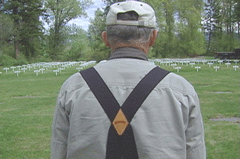
Libby resident, Bob Dedrick, looks out over the crosses displayed in 2002 at the community cemetery in honor of the known Libby asbestos victims. (A scene from “Libby, MT”)
CURWOOD: It’s Living on Earth. I’m Steve Curwood. A hundred years ago Libby, Montana was like so many other small towns in the American West. Its population grew to about 2700 as people came to work the timber and mining industries. And it looked like Libby had a bright future as it began mining what was branded as zonolite, a form of vermiculite that would be used as home insulation and fertilizer around the world. But as the years wore on, the mining company realized that its product was laced with tremolite, a type of asbestos that is particularly hazardous to health. And instead of warning its workforce of the dangers, it kept on mining. The story of Libby, Montana is the subject of a documentary film on the POV series on PBS, which airs August 28th. Drury Gunn Carr and Doug Hawes-Davis co-directed the film. I asked Dru to tell me what happens to people who are exposed to this mineral?
GUNN-CARR: What happens is this tremolite gets stirred up in the air during mining or in any kind of agitation and people breathe it in, and over time it starts to scar the lungs and turns into a disease called asbestosis. What happens is the lungs fill up with water essentially and they suffocate over time. So the other disease associated with it, two diseases, one is lung cancer and the other one is called mesothelioma, which is a very rare cancer of the outer lining of the lungs.
CURWOOD: I’d like to play some sound from your documentary now from an interview with a man named Les Skramstad who worked in the vermiculite mine. It was his first day on the job and he was excited about the opportunity he told you.

Director, Dru Gunn-Carr, shooting in Libby, Montana.(A scene from “Libby, MT”)
CURWOOD: So Les Skramstad takes this job at the plant and what happens to him and his health?
GUNN-CARR: Well, over time he started to develop a cough and had trouble breathing. And he went to the hospital and was told that he had asbestosis and that he had just a few years to live.
SKRAMSTAD: So, I went out and got in the car and started for home and I suppose, I guess we got about half way home probably, and I said to Norita, I said “Jesus you know what?” And she said, “what” I said, “I just got a death sentence.”
CURWOOD: What did he do about the fact that he had this disease from working at the mine?
GUNN-CARR: Well, Les was a very soft-spoken man and I think he probably found it difficult to speak out about his ailment. And Les was told by many that he was a troublemaker, that he was a reactionary and a radical. All those terms were used to describe anyone who came out and said “We have a problem in this town people are getting sick.”
CURWOOD: So, did he remain ostracized for the rest of his life?
GUNN-CARR: Well, no he didn’t. Les continued over the years to speak out publicly along with a handful of other people. And as the numbers of people being diagnosed with asbestosis in that town grew, the call for action also grew. Les passed away in January of this year, 2007. And it was very heartening to go to his funeral and see the hundreds of people who came in literally blizzard conditions to pay their respects.
CURWOOD: This is a town of what, about 2700 people and of this town, do I have this correct, more than 200 have died from lung disease and another 1200 have some form of lung disease?

Libby resident, Bob Dedrick, looks out over the crosses displayed in 2002 at the community cemetery in honor of the known Libby asbestos victims.
(A scene from “Libby, MT”)
GUNN-CARR: Yeah, it’s hard to get around those numbers. There’s now a clinic set up in Libby called the Center for Asbestos Related Disease and they report that they have something on the order of 1400 patients with some type of lung abnormality associated with asbestos exposure. And they estimate that around 270 people have died from asbestos-related disease.
CURWOOD: W.R. Grace was the company that was doing the mining in Libby, Montana can you tell me a bit about this company?
GUNN-CARR: Well, W.R. Grace has been around for a long time. They are a huge multinational corporation. You know W.R. Grace is one of the companies that was involved in the Woburn, Massachusetts lawsuits which ended up in the book and the film “A Civil Action”. So, they’re not unknown to be in issues associated with toxic material. And in the case of Libby, the on-scene coordinator for the EPA, Paul Peronard described Grace as being by far the most difficult corporation to work with. And that has been shown to be the case in Libby, where many people feel that they were betrayed by this company.
CURWOOD: What will happen and what has happened to W.R. Grace and its former employees?

Abandoned WR Grace vermiculite mine near Libby, Montana. (A scene from “Libby, MT”)
CURWOOD: What about criminal sanctions? Executives were indicted, as I understand it at some point. What’s happened in those cases?
GUNN-CARR: Yeah, it’s been ongoing for a couple of years now but in February of 2005, seven executives and managers from W. R. Grace were indicted on federal criminal charges for knowingly endangering the residents of Libby and concealing information about the health effects of its mining operations. And that case is due to come up in September of 2007, but it’s far from clear that any of these charges will stick.
CURWOOD: So, what’s the prospect for Libby ever getting all of this stuff cleaned up?
GUNN-CARR: Well, that’s the question and early in 2007 that’s exactly what EPA is doing. They’re doing a huge study to determine how clean the town needs to be in order to significantly reduce the risk of asbestos exposure.
CURWOOD: This asbestos-laced vermiculite was shipped all over the country to be used as insulation. How many homes do you think it’s in today?
GUNN-CARR: Well, that’s the big question. The Environmental Protection Agency estimates that somewhere around 35 million homes and buildings have some level of zonolite insulation from Libby. The question now is, ‘Is it safe to have zonolite insulation in your home if it’s sealed up?’ and that’s a question that the EPA has really failed to answer. One of the reasons that Libby for instance was never declared an emergency, was because if they did that they would have had to have taken out all the insulation from all the homes in Libby. But of course the problem with that is that if they did that they’d have to explain to the American public why they aren’t addressing zonolite insulation in all of these millions and millions of homes throughout the United States.
CURWOOD: Drury Gunn Carr and his partner Doug Hawes-Davis produced the documentary film, Libby Montana for the Point of View series on PBS that airs August 28th. Thank you so much sir.
CARR: Thank you.
[MUSIC: Bask “Hebyhalling” from ‘Bask’ (MNW Records Group – 1999)]
Related links:
- High Plains Films
- Point of View Documentary Series
- W.R. Grace on Libby, MT
Water Diaries

(Courtesy of S. Bhaskar)
CURWOOD: Scientists, government officials and activists from 130 countries just wrapped up World Water Week in Stockholm, an effort to bring more attention and resources to what they call a global water crisis. More than a billion people around the world do not have safe drinking water; another two-and-a-half billion lack basic sanitation.
Living on Earth decided to take a look at how we use water - here and in another part of the world. So, we asked our Washington correspondent Jeff Young to keep a diary of his water use for a day. And we asked a woman in a small village in southern India to do the same. The result is this day in the life, measured out in water.
[WATER POURING INTO KETTLE]
YOUNG: So this is how the day starts for me. Gotta get some coffee and jumpstart my morning.
[SOUND OF TOILET FLUSH AND TOOTH BRUSHING]
YOUNG: Brushing teeth, about half a gallon.
[SOUND SHOWER CURTAIN AND WATER]
YOUNG: So about eight minutes in the shower, three gallons for every flush of the toilet, a pint of water for coffee, I’m already up to 23 gallons of water and my day’s just getting started. The day starts quite differently 10 time zones away in the Indian state of Tamil Nadu. That’s where Mrs. Marhudhambal lives.
[SHOWER SOUNDS FADE TO VILLAGE SOUNDS]
[MARHUDHAMBAL UNDER TRANSLATOR]
TRANSLATOR: I live in Sukkampatti village in the state of Tamil Nadu with my husband and two children. First thing in the morning when we go to the bathroom we need water for that, to clean up. We have no bathroom. We must go to a field to defecate.
[SOUNDS OF CLEANING POTS AND PANS]
TRANSLATOR: I get up at five to get water for cooking and cleaning. Next, I splash water around the entrance to the house to keep down the dust. I really need two bowls of water for that but I don’t have enough, so I use only one.
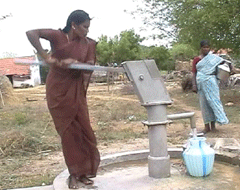
Mrs. Marudhambal pumps water. (Courtesy of S. Bhaskar)
TRANSLATOR: There is a water tank about a half-mile away. We fill our pots with water and carry them back. But we have to gather all the water before dark. There is no lighting and there are poisonous snakes and stinging insects along the path. When the electricity is out the water tank can’t be filled. Sometimes it will be four days with no water in the tank. When that happens I have to ride my bicycle about a mile to another water source.
[HAND PUMP SQEAKING]
TRANSLATOR: This hand pump water is like seawater. But we have no other choice.
[KA-CLUNK! OF BOTTLE IN SODA MACHINE]
YOUNG: One of the first things I see when I walk into the office building here at the capitol is this vending machine selling bottled water. So here’s a question: If I’m willing to plunk down a buck 25 for what is—let’s face it—repackaged tap water, well how much of my tax money should I be willing to spend to help out people like Mrs. Marhudhambal around the world? It’s a question some people here on Capitol Hill are starting to ask.
BLUMENAUER: We are facing a global crisis with lack of sanitation and safe drinking water when we are a country that spends upwards of 20 billion dollars a year on bottled water.
YOUNG: That’s Oregon Democratic Representative Earl Blumenauer. The number he uses is at the high end of estimates of water sales. Industry figures point to about 15 billion a year, retail. But Blumenauer’s point is this: 15 billion for bottled water is 250 times what the government put toward global water development. Blumenauer’s pushing for more money for the Safe Water for the Poor Act. Congress passed that law two years ago but failed to provide much funding.
BLUMENAUER: It is a drop in the bucket. We ended up last year with something like 60 million dollars for this global need and less than 10 million for all of sub-Saharan Africa. It’s going to require hundreds of millions of dollars added to this effort on an annual basis. But this is within our capacity.

This is how Mrs. Marudhambal spends much of her day--carrying pots of water a half mile or more. All her family's water--drinking, cooking, bathing, even watering livestock--arrives this way. Global water agencies estimate that some people in the developing world spend a quarter of their waking hours in pursuit of water. (Courtesy of: S. Bhaskar)
YOUNG: The Water for the Poor Act directs the State Department to make water and sanitation development part of U.S. foreign policy. Gary White at the non-profit group Water Partners International says the money doesn’t still flow to those most in need.
WHITE: You know, our foreign policy isn’t really focused right now on helping people out of poverty now as much as it is on other goals.
YOUNG: White says water funding is siphoned away to expensive projects in Afghanistan, Iraq and around the Middle East, areas where the U.S. wants to counter terrorism. White argues for a policy that also emphasizes getting water to the neediest.
WHITE: If the United States had a Marshall plan for water supply and said ‘we’re going to get water to a billion people around the world,’ and that became a centerpiece of our foreign policy you can imagine the goodwill that the United States would have. I think it would be hard to imagine a world that would have a critical mass of people wanting to attack us if we had taken on such a great goal for humanity.
[SOUNDS OF A DISHWASHER]
YOUNG: So back home for a few chores. According to the owners manual the dishwasher uses seven gallons per wash cycle.
[WATERING CAN]
YOUNG: These basils look thirsty watering the plants about another six gallons.
[BABY SQUEALING]

Jeff doesn't worry much about his baby, Hazel, getting sick from the
water... (Jeff Young)
YOUNG: Bathtime for baby: not a lot of water used but a moment to think about water quality rather instead of the quantities. D.C.’s water did have some lead in it for a while we used filters, we still use a filter, that takes care of that. But we don’t give a second thought as to whether contact with water is going to make our baby sick. That’s a real luxury elsewhere around the world. In fact, the United Nations figures tell us that diseases caused by the exposure to dirty water is the second leading cause of childhood death around he world—4900 children will die today as a result of being exposed to dirty water.
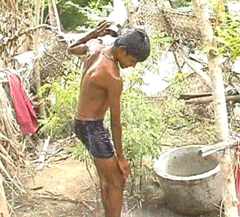
Waterborne illness is a constant concern for Mrs. Marudhambal as her son bathes outdoors. U.N. statistics say contact with dirty water leads to 4,900 childhood deaths around the world every day.
(Courtesy of S. Bhaskar)
[VILLAGE SOUNDS]
TRANSLATOR: We took water samples from two wells and the hand pump we use. We took the water to the local officials. After tasting it they said the water is not fit to drink. They wondered how anyone drinking it could survive.
[CLOTHES WASHING BY HAND]
TRANSLATOR: For washing clothes I need 10 pots of water if I need the clothes to be very clean. The farmers won’t allow us to wash or to clean clothes at the water well.
They think the soap will pollute the water they need for crops. So we have to carry the water home for washing clothes.
[WATER SPLASHING, BOY BATHING OUTDOORS]
TRANSLATOR: We need to bathe every day. I need three pots of water for each person. That’s a total of 12 pots of water for bathing alone.
[FOUNTAIN SOUNDS]
YOUNG: I thought it would be a fitting way to wrap up this day with a little evening stroll around some of the fountains here on the capitol grounds.
YOUNG: So how do we compare at the end of the day, Mrs. Marudhambal and I? There was a bit of guesswork involved here, I’ve got to admit, but I used about 95 gallons of water. The average American uses somewhere between 100 and 160 gallons a day, depending on what activities you include. Mrs. Marudhambal’s family used a little under 30 gallons of water per person. But what struck me about her was not so much the amount of water used but the time and energy spent getting it. Imagine the other things she could be doing with her time and energy.
[FOUNTAIN SOUNDS]
YOUNG: We take this resource so much for granted, water is almost invisible to us. And the people around the world who go without water, well they’re pretty much invisible to us, too. It’s kind of like water itself. You see through it until the light catches it just right. Then you see yourself reflected in it.
For Living on Earth I’m Jeff Young in Washington.
[MUSIC: Olov Johansson “Stormyren (The Big Bog) from ‘Storsvarten’ (Drone Music AB – 1998, East Side, Inc. - 1998)]
CURWOOD: Thanks to Shobila Kaligounder, the Tamil Sangam, Global Water Challenge, and Water Partners International for their help in translating our water diary from India.
[MUSIC CONTINUES]
Related links:
- American Waterworks Assoc. has a nifty page that helps you calculate your water diary
- Water Partners International is a good place to explore global water needs
- Track the Water for the Poor Act
CURWOOD: Just ahead what’s in a name? A lot when there’s talk about updating the taxonomy of all living things great and small—the Linnean system.
Keep listening to Living on Earth.
ANNOUNCER: Support for the environmental health desk at Living on Earth comes from the Cedar Tree Foundation. Support also comes from the Richard and Rhoda Goldman Fund for coverage of population and the environment.
This is Living on Earth, on PRI: Public Radio International.
Cool Fix
CURWOOD: It’s Living on Earth. I’m Steve Curwood. Coming up: the dog days of summer for Elvis, Rumsfield and other animals at Bedlam Farm. But first this Cool Fix for a Hot Planet from Amy Fish.
[CHURCH BELLS]
FISH: The Anglican Church has vowed to reduce its carbon footprint by 60 percent in the next half century. According to the Church of England, their Creation Care program is the Green Gospel.
[THEME]
Anglican leaders want to equip old churches with energy-efficient lights, recycling bins, and compost heaps. They’re urging worshippers to carpool to Sunday service and to cut back on carbon emissions at home. And they’ve sent pamphlets to every Anglican parish that say caring for the earth is their Christian duty.
But it’s one Bishop’s fiery version of the Green Gospel that’s captured England’s attention. Officially, he’s the Right Reverend and Right Honorable Richard Chartres, Bishop of London, the third most senior member of the Church of England. But now he’s better known as the Green Bishop.
The Green Bishop shocked Londoners by announcing that wasting energy is a sin. He condemned using gas-guzzling cars and excess plane travel as selfish and un-Christian. The London press told him to practice what he preached—and the Bishop took the scolding seriously. He’s now halfway through a year-long flying fast that’s forced him to turn down conference invitations all over the world.
The Bishop is also limiting his car use. He still uses his chauffeured vehicle for the days he wears full regalia. But on other days, the Green Bishop rides the London Underground.
That’s this week’s Cool Fix for a Hot Planet. I’m Amy Fish.
Losing Linnaeus?
CURWOOD: Everything in nature has its place: Kingdom, Phylum, Class, Order, Family, Genus, Species. We can thank Swedish biologist Carl Linnaeus for the organization of our naming system. But now, 300 years after the birth of Linnaeus, new tools in DNA analysis are shaking up the tree of life. Things we thought were on one branch seem to fit better on another. And moving them gets a bit messy when a naming system is hierarchical. So some scientists think it's time for an update of the Linnean system of nomenclature. Living on Earth’s Ian Gray has our story.
[CLAP OF THUNDER]
GRAY: When I first heard someone was thinking of changing the way everything in nature is named, I thought the world would collapse into a fiery ball of chaos. The first person I thought of was my 7th grade science teacher Mr. Uecker.
GRAY: Do you remember when we learned about the tree of life?
UECKER: Uh huh. You’d use mnemonics. Kingdom, Phylum, Class, Order Family Genus Species instead of learning that you’d learn some tricky little sentence that would go with it, such as…King Philip… something about fried green spinach.
GRAY: Yeah, the one I really remember is that ‘King Philip Came Over for Green Spinach.’
UECKER: Came over for green spinach. Yeah, that was one. And the weirder it got, the easier it was for you guys to remember.
GRAY: Anyway this whole King Philip thing was a total revelation for me. I mean you got the whole structure of life in a single sentence. But how did we get that structure in the first place?
BARRIE: Linnaeus was born in 1707 and at that time, the botanists that were working in Europe all communicated in Latin.
GRAY: That’s Fred Barrie, botanist with the Missouri Botanical Garden and a Linnaean nut.
BARRIE: And at the time, the name for a species would have been a genus name plus a descriptive phrase. I can give you an example of one if you like?
GRAY: Sure. Why don’t you…
ANGRY EDITOR: Ian, you’ve got to get out the studio we have an editorial meeting now.
GRAY: Um…can’t you see I’m in the middle of an interview?
ANGRY EDITOR: Yeah, sorry too bad. Gotta get out, we gotta go.
GRAY: Okay, sorry about this, hey Gurgi?
GURGI: Yes.
GRAY: Can you fill in here for a second. We were just about to hear from Dr. Barrie how confusing animal and plant names were before Linneaeus came along.
GURGI: No Problem, I take over.
BARRIE: If you look at bananas,
GURGI: Yummm bananas!!!
BARRIE: The correct scientific name for a banana today is musa paradisica.
GURGI: Okay.
BARRIE: Bowhein from the 16th century called it Feicus indica fructa recimo folio oblongo.
GURGI: Oblongogo?
BARRIE: Linnnaeus originally called it musa cliffordiana. But then changes his mind and calls it Musa recimo simplicimo.
GURGI: Grrr..Linnaeus!
BARRIE: And Musa spatami nutantae.
GURGI: Ahhh…Ian, Help!
[DOOR SLAMS]
GRAY: OK Gurgi. Sorry about that, okay I’m back. Here’s how Linnaeus fixed this taxonomic tangle. When he was putting together his famous book on plants he scribbled in the margins a single Latin noun to help him remember each species. When his book published, people realized these margin notes were easier to remember than the actual species name.
BARRIE: And it caught on very quickly, within two years people were publishing using this system, using this binomial system.
GRAY: So, Linnaeus, almost by accident, made it easy for people to talk to each other about how species are related. And now that system is well, law.
EGGLETON: There are rules for how you name animals and these rules are all written down in a nice red book.
GRAY: That’s Paul Eggleton.
EGGLETON: I work at the Natural History in London and I’m a specialist on termites.
GRAY: And he’s a fan of the this red book called, the International Code of Zoological Nomenclature. It governs how groups of organisms are named. But Eggleton’s crew recently caused a stir with a discovery about termites.
EGGLETON: Well, for a long time it’s been known that their closest relatives are praying mantises and cockroaches. But it turns out that as more information has come in, especially as we’ve started to use DNA in these analyses, we’ve now begun to realize that termites are nested within cockroaches, that they’re actually social cockroaches.
GRAY: Turns out this is something of a bummer for the termites.
EGGLETON: To go from an Order to a Family is a considerable demotion for a group.
GRAY: But it gets worse for termites. According to the red book, since termites are no longer at the Order level of the tree, they have to lose their Order level name—Isoptera. The code works like this: all Order level names end with the suffix “a”: Hymenoptera – the ants, Coleoptera – the beetles, Blattodea – the cockroaches etc. Family level names end with d-a-e…dae. So for the newly demoted termites…
EGGLETON: What they become instead of being the Isoptera they become the Termitidae, which is the correct form of the name if you’re going to treat them as a family.
GRAY: Discoveries like this cause a cascade of name changes that hinder the process of keeping the tree up to date. But Michael Donoghue, a botanist and the curator of the Peabody Museum of Natural History at Yale University, says it doesn’t have to be that way. To deal with this cascade problem, he and a group of scientists are developing something they call the PhyloCode.
DONOGHUE: In my view the idea is to not to have to assign a rank for anything.
GRAY: For anything, nothing? No ranks?
DONOGHUE: Right. Just get rid of those things. They’re not necessary.
GRAY: If Donoghue could have his way, people would no longer talk about species and larger groups of organisms by referring to them as an Order or a Family or any of that.
DONOGHUE: So the cat Family so to speak is really not equivalent to the sunflower Family in any normal way. And so, we start to communicate as though it means something, but it really doesn’t mean anything at all. There’s not the same number of species, they’re not the same age, they don’t have the same ecological breadth, so there’s no particular way in which something we call a Family is equivalent to another Family.
GRAY: And so in the case of the termites…
DONOGHUE: Under the PhyloCode way of thinking about it, you keep the name Isoptera for the termites. You know, termite is a termite, Isoptera, you know they’re the same. We haven’t changed our knowledge of that. The only thing that’s changed is our knowledge of how they’re related to cockroaches and other relatives and things like that.
GRAY: Donoghue would simply name the new part of the tree where termites branch off from their wood-boring cockroach brethren. In other words, the PhyloCode would allow us to create more branches to keep up with our discoveries of new relationships. But scientists like Eggleton from the Natural History Museum of London think the PhyloCode would require too much of an overhaul.
EGGLETON: Especially working in the kind of institution that I work in, which has an enormous amount of information classified and databased using that system, to suddenly change the system would be a disaster for us.
GRAY: Getting rid of ranks would change how textbooks are written, articles are published and how laws about species get drafted. Other opponents, like taxonomist Kurt Pickett from the University of Vermont, argue that even if the PhyloCode was a good idea, its timing is not.
PICKETT: We are in the midst of a biodiversity crisis in this world and just now is not the time to institute some new scheme that is going to hurl us into taxonomic and nomenclatural confusion.
GRAY: Despite dire predictions, Donoghue and others are forging ahead. They’ll publish their code next year.
DONOGHUE: I feel like there’s never a good time for this kind of stuff in a way. So, you know to me, it’s like why should it be set in stone, why shouldn’t this be something that changes, just like everything else in science. It seems like it’s been lucky that it’s lasted 300 years. That’s longer than most things last in science.
GRAY: Science applied to it’s own tradition, or needless chaos? For Living on Earth, I’m Ian Gray.
[MUSIC: Randy Newman “Circus Bugs” from ‘A Bug’s Life’ (Walt Disney Records/Pixar -1998)]
Related links:
- Beta Version of the PhyloCode
- “PhyloCode is Fatally Flawed” Article
Dog Days
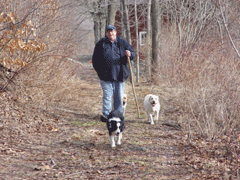
Author Jon Katz (Peter Hanks)
CURWOOD: Five years ago, Jon Katz left behind his life as a mystery writer in suburban New Jersey and took to the hills of upstate New York to buy a farm. His growing menagerie of dogs and farm animals, and sometimes rocky transition to rural life has provided him with plenty of material to continue writing. Jon Katz’s latest book is called “Dog Days: Dispatches from Bedlam Farm.” Hello, Jon.
KATZ: Hi Steve, thanks for having me on.
CURWOOD: So, how does a guy from Jersey wind up on a farm?
KATZ: A good question. My wife also asks this quite often and um I’m working on that. You know it was never my dream to have a farm. I’m not sure I ever really set foot on a farm other than to buy some corn, in my life. I was driving past this place and I looked up this hill and I saw this sprawling old farmhouse, Civil War farmhouse, with four collapsing barns on a beautiful hill. And I just wanted it. And I thought being middle-aged does not mean to me that I have to stop learning and growing and changing. So I think it’s neat to pursue a dream at that point in life when you’re in danger of kind of closing up a bit, shutting down a bit, getting rusty, to be thrown into this new and very enthralling experience. It’s been good for me as a writer. It’s been good for me as a human, and I’m very grateful for it.
CURWOOD: Now, your new book is called “Dog Days” does this just mean summer, John?
KATZ: Well, it means summer. It means a bunch of things. But I discovered in researching the book, it was a specific period of time, July 3rd through August 11th that the Romans called the dog days or the days of great heat because Sirius the dog star rises with the sun during those days and the Romans blame those two stars for the warmth. When I learned this I took my two dogs up the hill behind the farm and sat there at four in the morning and waited for Sirius to come up. I wanted to check this out, being a former journalist. And it’s true this quite beautiful star pops out with the sun. So, it’s become a tradition on the farm now, several times during the dog days, which also to me are a state of mind, kind of a time where even in America we slow down, take a breath. To me it was about reconnecting with nature, which is sort of what had happened to me on the farm. Reconnecting with animals, reconnecting with the animal parts of me. The term kind of fleshed out for me.

“Dispatches from Bedlam Farm”
CURWOOD: I’m looking at the cover of your new book, “Dog Days, Dispatches from Bedlam Farm” and who am I looking at on your cover?
KATZ: That is Izzy who is lying right at my feet as we speak. And he’s my media dog. He accompanies me on the book tour. He came from a farm nearby. People bought the farm and left him and another border collie pretty much on their own for four or five years. And he came to me, of course to train and of course find a new home, naturally. And he’s still here, naturally, as is the other dog. And so it goes. The motto of the farm should be “one thing leads to another”. Which is how I have four donkeys, two steers, a cow, a rooster, a bunch of sheep, and tomorrow two goats.
CURWOOD: (laughs) Ok, now I want to ask you about your other border collie, Rose, and tell me a story about her when you bought a new ram back to the farm.
KATZ: Well, Rose is my hero. Rose is a four-year-old border collie. She is really the farm manager is the best way I can describe her. And Rose is waiting for the ram. Usually they’re pretty belligerent. They can butt and bump into people. In the case of last year’s ram, I believe his name was Rumsfield. And he came in and everyone warned me to be careful around him. And Rose is eyeing him carefully. I let him in and he struts around and kind of unnerves the ewes and glowers at everybody and butts towards me and then I let Rose in. She marches up the hill with her head to the ground giving him the eye and he rushed out to challenge her. At which point she circled around him and came up behind him and attached herself to his private parts and hung on. And I heard this piercing scream and he ran around for a couple minutes. And then she ran around and was waiting for him on the other side and nipped at his nose and spun him around in circles. And he eventually ran into the center of the flock of ewes and hid.
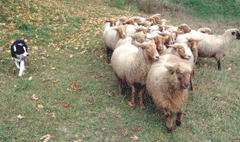
Rose at work (Peter Hanks)
KATZ: So much for the tough guy.
CURWOOD: So you call your place Bedlam Farm and it certainly sounds like it. You have all kinds of animals there and then you have a steer named Elvis.
KATZ: Elvis was a little more complicated story because a dairy farmer came to my farm one day and said he had a problem. First time in 45 years that he had a steer he could not send to market. He was looking very uncomfortable because farmers don’t usually have a lot of trouble doing that. He called him Brownie at the time. He said, “I have this guy named Brownie. He just doesn’t want to get on the truck. I feel like he knows me. He follows me around. He puts his head on my shoulder. He’s staring at me all the time. I just can’t put him on the truck.” Of course I realized that a farmer can’t really keep a steer as a pet. That would look bad. And giving him away for free would be even worse. So, he has to find a big enough idiot to take him and feed him for years, which he thought he had found in me. Which he did, I bought him for 500 bucks.
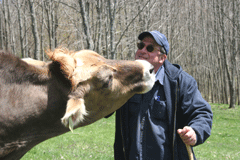
Jon gets a kiss from notorious steer, Elvis (Raeanne Wright)
KATZ: He is very sociable. He comes up and puts his head on my shoulder and he likes to kiss me. He eats my hat. He can be a little drooly. You have not been kissed until you’ve been kissed by Elvis. Elvis reminds me a bit of Shreck, you know he’s very loveable and very big and people tend to run when they see him. He is sweet. How can I tell you? I never thought I would know a steer. I never thought I would love a steer. But I go up in the morning with him and we sit and stare out at the green hills of Vermont. And he has this great contemplative quality. He can sit for hours and do nothing in particular with great enthusiasm. So, I’m very fond of him.

Author Jon Katz (Peter Hanks)
CURWOOD: So, John Katz, you’ve been doing this now for…this is year five?
KATZ: Yes, this is the fifth year.
CURWOOD: So, you’re in this for the long haul?
KATZ: Yes, absolutely I feel you know there’s a physical component to running a farm. I had my troubles there. You know I had um frost bite, a lot back trouble, I’ve fallen down many times, ice is brutal, there’s a lot of lifting. There does come a point, I’m sure where you have to kind of be realistic about it and say you can’t do it any more but I don’t feel even close to that point. I’ve gotten some really good help. And I see the farm as a very, very positive beautiful experience for me. I just, there’s 20 more books I want to write. So, I just feel I’ve come home. I don’t feel I’m in a strange place. I feel I am where I belong. I couldn’t explain why that’s true but it is.
CURWOOD: John Katz’s newest book is called “Dog Days, Dispatches from Bedlam Farm” Thanks so much John.
KATZ: Thank you very much.
CURWOOD: On the next Living on Earth. A river has always run through the Amazon rain forest, and since 1959, so has a road…bringing settlers, death and destruction to the indigenous population.
ZMECKHOL: In the first contact they shook hands and the same evening they were all sick so they were 900 people and they went down to 200: 700 people died.
CURWOOD: Life and death in the Amazon Rain Forest…next time on Living on Earth.
[WIND AND BIRD CALLS]
We leave you this week, dry and up high in the New Mexican desert. In the early dawn, gusts of wind blow across the open landscape as ravens, western meadowlarks, and mockingbirds sing. Ruth Happel recorded this desert serenade for the wildsanctuary.com soundscape series.
[MUSIC: “Desert Serenade “ recorded by Ruth Happel ‘Desert Solitudes’ (Wild Sanctuary (BMI) – 2002)]
CURWOOD: Living on Earth is produced by the World Media Foundation. Our crew includes Ashley Ahearn, Eileen Bolinsky, Bruce Gellerman, Ian Gray, Ingrid Lobet, and Jeff Young - with help from Bobby Bascomb, and Kelley Cronin. Our interns are Lauren Cox and Amy Fish. Aaron Read engineered this week’s program.
Alison Lirish Dean composed our themes. You can find us anytime at LOE dot org. I’m Steve Curwood, from all of us here at Living on Earth thanks for listening.
ANNOUNCER: Funding for Living on Earth comes from the National Science Foundation, supporting coverage of emerging science; And Stonyfield Farm: Organic yogurt and smoothies. Stonyfield pays its farmers not to use artificial growth hormones on their cows. Details at Stonyfield dot com.
Support also comes from you our listeners, the Ford Foundation, the Wellborn Ecology Fund, and Pax World Mutual Funds—socially and environmentally sustainable investing. Pax World, for tomorrow. On the Web at paxworld dot com.
ANNOUNCER2: PRI, Public Radio International.
Living on Earth wants to hear from you!
Living on Earth
62 Calef Highway, Suite 212
Lee, NH 03861
Telephone: 617-287-4121
E-mail: comments@loe.org
Newsletter [Click here]
Donate to Living on Earth!
Living on Earth is an independent media program and relies entirely on contributions from listeners and institutions supporting public service. Please donate now to preserve an independent environmental voice.
NewsletterLiving on Earth offers a weekly delivery of the show's rundown to your mailbox. Sign up for our newsletter today!
 Sailors For The Sea: Be the change you want to sea.
Sailors For The Sea: Be the change you want to sea.
 The Grantham Foundation for the Protection of the Environment: Committed to protecting and improving the health of the global environment.
The Grantham Foundation for the Protection of the Environment: Committed to protecting and improving the health of the global environment.
 Contribute to Living on Earth and receive, as our gift to you, an archival print of one of Mark Seth Lender's extraordinary wildlife photographs. Follow the link to see Mark's current collection of photographs.
Contribute to Living on Earth and receive, as our gift to you, an archival print of one of Mark Seth Lender's extraordinary wildlife photographs. Follow the link to see Mark's current collection of photographs.
 Buy a signed copy of Mark Seth Lender's book Smeagull the Seagull & support Living on Earth
Buy a signed copy of Mark Seth Lender's book Smeagull the Seagull & support Living on Earth

